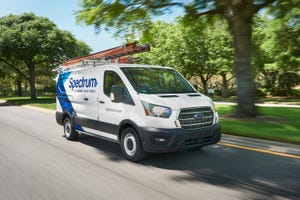
As expected, Verizon spent the most money in the FCC's recently concluded 3.5GHz midband spectrum auction.
The action is no surprise: Light Reading reported more than a year ago that Verizon has been deploying antennas into its network that can support transmissions in the 3.5GHz CBRS band to add additional capacity to its 4G and 5G networks.
Other big winners in the auction include Dish Network, Comcast, Charter Communications and Cox. These results also don't come as a surprise: Light Reading reported almost a year ago that Charter was preparing to build a wireless network, as well as interest from Dish and Comcast in spectrum. Light Reading also reported earlier this year that Cox is preparing to re-enter the mobile industry.
The cable companies are widely expected to build wireless networks in their cable footprints using CBRS spectrum to move their mobile customers' traffic onto their own wireless networks, thus reducing the amount of money they pay to their MVNO partners like Verizon.
Due to FCC rules, auction winners cannot yet discuss their plans for the spectrum.
Meantime, Dish is moving forward with its plan to build a nationwide 5G network.
Other major bidders in the FCC's CBRS spectrum auction include smaller cable companies like Cable One, Shentel and Mediacom, as well as telecom operators like Windstream and VTX1 Companies. Several smaller fixed and mobile wireless network operators including Viaero, Nextlink Internet, Watch Communications and U.S. Cellular also purchased spectrum. These companies likely will use CBRS spectrum to offer mobile services or to improve their existing mobile networks, or to offer fixed wireless Internet services.
A number of unexpected bidders emerged among the more than 200 spectrum winners in the auction. For example, several utility providers, including Sempra Energy, Southern California Edison and Alabama Power purchased spectrum; such companies have expressed interest in spectrum for private wireless networks for utility-monitoring services. And JBG SMITH is a major real estate company that could use CBRS spectrum for indoor wireless offerings.
Company | Bidding Entity | Number of Licenses Won | Net Payment | |
1 | Verizon | Verizon Wireless Network Procurement | 557 | $1,893,791,991 |
2 | Dish Network | Wetterhorn Wireless | 5,492 | $912,939,410 |
3 | Charter | Spectrum Wireless Holdings | 210 | $464,251,209 |
4 | Comcast | XF Wireless Investment | 830 | $458,725,900 |
5 | Cox | Cox Communications | 470 | $212,805,412 |
6 | Southern California Edison | Southern California Edison Company | 20 | $118,951,433 |
7 | Windstream | Windstream Services | 1,014 | $38,534,863 |
8 | Mediacom | Mediacom | 576 | $29,478,887 |
9 | Nextlink Internet | AMG Technology Investment Group | 1,072 | $28,489,750 |
10 | JBG SMITH | SEAD | 7 | $25,274,477 |
11 | Sempra Energy | San Diego Gas and Electric Company | 3 | $21,273,340 |
12 | ATN International | SAL Spectrum | 1,569 | $20,396,530 |
13 | Claro Puerto Rico | Puerto Rico Telephone Company | 231 | $18,887,528 |
14 | Alabama Power | Alabama Power Company | 271 | $18,878,280 |
15 | Shentel | Shenandoah Cable Television | 262 | $16,118,381 |
16 | VTX1 Companies | VTX Communications | 112 | $15,373,263 |
17 | Viaero | NE Colorado Cellular | 558 | $15,087,268 |
18 | U.S. Cellular | United States Cellular Corporation | 243 | $13,538,232 |
19 | Watch Communications | W.A.T.C.H. TV Company | 517 | $10,942,047 |
20 | Cable One | Cable One | 547 | $10,544,441 |
Source: The FCC |
— Mike Dano, Editorial Director, 5G & Mobile Strategies, Light Reading | @mikeddano
About the Author(s)
You May Also Like




_International_Software_Products.jpeg?width=300&auto=webp&quality=80&disable=upscale)







